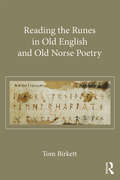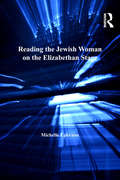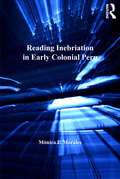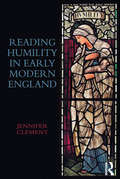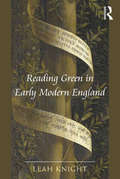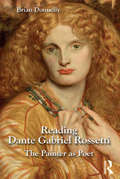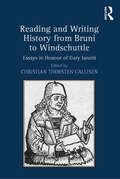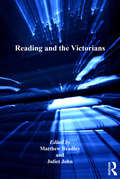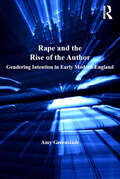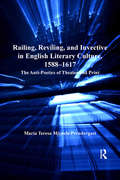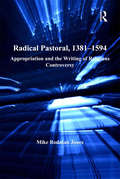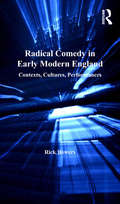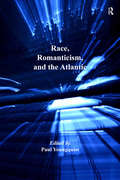- Table View
- List View
Reading the Runes in Old English and Old Norse Poetry
by Thomas BirkettReading the Runes in Old English and Old Norse Poetry is the first book-length study to compare responses to runic heritage in the literature of Anglo-Saxon England and medieval Iceland. The Anglo-Saxon runic script had already become the preserve of antiquarians at the time the majority of Old English poetry was written down, and the Icelanders recording the mythology associated with the script were at some remove from the centres of runic practice in medieval Scandinavia. Both literary cultures thus inherited knowledge of the runic system and the traditions associated with it, but viewed this literate past from the vantage point of a developed manuscript culture. There has, as yet, been no comprehensive study of poetic responses to this scriptural heritage, which include episodes in such canonical texts as Beowulf, the Old English riddles and the poems of the Poetic Edda. By analysing the inflection of the script through shared literary traditions, this study enhances our understanding of the burgeoning of literary self-awareness in early medieval vernacular poetry and the construction of cultural memory, and furthers our understanding of the relationship between Anglo-Saxon and Norse textual cultures. The introduction sets out in detail the rationale for examining runes in poetry as a literary motif and surveys the relevant critical debates. The body of the volume is comprised of five linked case studies of runes in poetry, viewing these representations through the paradigm of scriptural reconstruction and the validation of contemporary literary, historical and religious sensibilities.
Reading the Runes in Old English and Old Norse Poetry
by Thomas BirkettReading the Runes in Old English and Old Norse Poetry is the first book-length study to compare responses to runic heritage in the literature of Anglo-Saxon England and medieval Iceland. The Anglo-Saxon runic script had already become the preserve of antiquarians at the time the majority of Old English poetry was written down, and the Icelanders recording the mythology associated with the script were at some remove from the centres of runic practice in medieval Scandinavia. Both literary cultures thus inherited knowledge of the runic system and the traditions associated with it, but viewed this literate past from the vantage point of a developed manuscript culture. There has, as yet, been no comprehensive study of poetic responses to this scriptural heritage, which include episodes in such canonical texts as Beowulf, the Old English riddles and the poems of the Poetic Edda. By analysing the inflection of the script through shared literary traditions, this study enhances our understanding of the burgeoning of literary self-awareness in early medieval vernacular poetry and the construction of cultural memory, and furthers our understanding of the relationship between Anglo-Saxon and Norse textual cultures. The introduction sets out in detail the rationale for examining runes in poetry as a literary motif and surveys the relevant critical debates. The body of the volume is comprised of five linked case studies of runes in poetry, viewing these representations through the paradigm of scriptural reconstruction and the validation of contemporary literary, historical and religious sensibilities.
Reading the Jewish Woman on the Elizabethan Stage
by Michelle EphraimThe first book-length examination of Jewish women in Renaissance drama, this study explores fictional representations of the female Jew in academic, private and public stage performances during Queen Elizabeth I's reign; it links lesser-known dramatic adaptations of the biblical Rebecca, Deborah, and Esther with the Jewish daughters made famous by Christopher Marlowe and William Shakespeare on the popular stage. Drawing upon original research on early modern sermons and biblical commentaries, Michelle Ephraim here shows the cultural significance of biblical plays that have received scant critical attention and offers a new context with which to understand Shakespeare's and Marlowe's fascination with the Jewish daughter. Protestant playwrights often figured Elizabeth through Jewish women from the Hebrew scripture in order to legitimate her religious authenticity. Ephraim argues that through the figure of the Jewess, playwrights not only stake a claim to the Old Testament but call attention to the process of reading and interpreting the Jewish bible; their typological interpretations challenge and appropriate Catholic and Jewish exegeses. The plays convey the Reformists' desire for propriety over the Hebrew scripture as a "prisca veritas," the pure word of God as opposed to that of corrupt Church authority. Yet these literary representations of the Jewess, which draw from multiple and conflicting exegetical traditions, also demonstrate the elusive quality of the Hebrew text. This book establishes the relationship between Elizabeth and dramatic representations of the Jewish woman: to "play" the Jewess is to engage in an interpretive "play" that both celebrates and interrogates the religious ideology of Elizabeth's emerging Protestant nation. Ephraim approaches the relationship between scripture and drama from a historicist perspective, complicating our understanding of the specific intersections between the Jewess in Elizabethan drama, biblical commentaries, political discourse, and popular culture. This study expands the growing field of Jewish studies in the Renaissance and contributes also to critical work on Elizabeth herself, whose influence on literary texts many scholars have established.
Reading the Jewish Woman on the Elizabethan Stage
by Michelle EphraimThe first book-length examination of Jewish women in Renaissance drama, this study explores fictional representations of the female Jew in academic, private and public stage performances during Queen Elizabeth I's reign; it links lesser-known dramatic adaptations of the biblical Rebecca, Deborah, and Esther with the Jewish daughters made famous by Christopher Marlowe and William Shakespeare on the popular stage. Drawing upon original research on early modern sermons and biblical commentaries, Michelle Ephraim here shows the cultural significance of biblical plays that have received scant critical attention and offers a new context with which to understand Shakespeare's and Marlowe's fascination with the Jewish daughter. Protestant playwrights often figured Elizabeth through Jewish women from the Hebrew scripture in order to legitimate her religious authenticity. Ephraim argues that through the figure of the Jewess, playwrights not only stake a claim to the Old Testament but call attention to the process of reading and interpreting the Jewish bible; their typological interpretations challenge and appropriate Catholic and Jewish exegeses. The plays convey the Reformists' desire for propriety over the Hebrew scripture as a "prisca veritas," the pure word of God as opposed to that of corrupt Church authority. Yet these literary representations of the Jewess, which draw from multiple and conflicting exegetical traditions, also demonstrate the elusive quality of the Hebrew text. This book establishes the relationship between Elizabeth and dramatic representations of the Jewish woman: to "play" the Jewess is to engage in an interpretive "play" that both celebrates and interrogates the religious ideology of Elizabeth's emerging Protestant nation. Ephraim approaches the relationship between scripture and drama from a historicist perspective, complicating our understanding of the specific intersections between the Jewess in Elizabethan drama, biblical commentaries, political discourse, and popular culture. This study expands the growing field of Jewish studies in the Renaissance and contributes also to critical work on Elizabeth herself, whose influence on literary texts many scholars have established.
Reading Inebriation in Early Colonial Peru (New Hispanisms: Cultural and Literary Studies)
by Mónica P. MoralesViewing a variety of narratives through the lens of inebriation imagery, this book explores how such imagery emerges in colonial Peru as articulator of notions of the self and difference, resulting in a new social hierarchy and exploitation. Reading Inebriation evaluates the discursive and geo-political relevance of representations of drinking and drunkenness in the crucial period for the consolidation of colonial power in the Viceroyalty of Peru, and the resisting rhetoric of a Hispanicized native Andean writer interested in changing stereotypes, fighting inequality, and promoting tolerance at imperial level in one of the main centers of Spanish colonial economic activity in the Americas. In recognizing and addressing this imagery, Mónica Morales restores an element of colonial discourse that hitherto has been overlooked in the critical readings dealing with the history of sixteenth and early seventeenth-century Andes. She presents drinking as the metaphorical site where Western culture and the New World collide and define themselves on the grounds of differing drinking rituals and ideas of moderation and excess. Narratives such as dictionaries, legal documents, conversion manuals, historical writings, literary accounts, and chronicles frame her context of analysis.
Reading Inebriation in Early Colonial Peru (New Hispanisms: Cultural and Literary Studies)
by Mónica P. MoralesViewing a variety of narratives through the lens of inebriation imagery, this book explores how such imagery emerges in colonial Peru as articulator of notions of the self and difference, resulting in a new social hierarchy and exploitation. Reading Inebriation evaluates the discursive and geo-political relevance of representations of drinking and drunkenness in the crucial period for the consolidation of colonial power in the Viceroyalty of Peru, and the resisting rhetoric of a Hispanicized native Andean writer interested in changing stereotypes, fighting inequality, and promoting tolerance at imperial level in one of the main centers of Spanish colonial economic activity in the Americas. In recognizing and addressing this imagery, Mónica Morales restores an element of colonial discourse that hitherto has been overlooked in the critical readings dealing with the history of sixteenth and early seventeenth-century Andes. She presents drinking as the metaphorical site where Western culture and the New World collide and define themselves on the grounds of differing drinking rituals and ideas of moderation and excess. Narratives such as dictionaries, legal documents, conversion manuals, historical writings, literary accounts, and chronicles frame her context of analysis.
Reading Humility in Early Modern England
by Jennifer ClementWhile humility is not especially valued in modern Western culture, Jennifer Clement argues here, it is central to sixteenth- and seventeenth-century understandings of Christian faith and behavior, and is vital to early modern concepts of the self. As this study shows, early modern literary engagements with humility link it to self-knowledge through the practice of right reading, and make humility foundational to any proper understanding of human agency. Yet humility has received little critical interest, and has often been misunderstood as a false virtue that engenders only self-abjection. This study offers an overview of various ways in which humility is discussed, deployed, or resisted in early modern texts ranging from the explicitly religious and autobiographical prose of Katherine Parr and John Donne, to the more politically motivated prose of Queen Elizabeth I and the seventeenth-century reformer and radical Thomas Tryon. As part of the wider 'turn to religion' in early modern studies, this study seeks to complicate our understanding of a mainstream early modern virtue, and to problematize a mode of critical analysis that assumes agency is always defined by resistance.
Reading Humility in Early Modern England
by Jennifer ClementWhile humility is not especially valued in modern Western culture, Jennifer Clement argues here, it is central to sixteenth- and seventeenth-century understandings of Christian faith and behavior, and is vital to early modern concepts of the self. As this study shows, early modern literary engagements with humility link it to self-knowledge through the practice of right reading, and make humility foundational to any proper understanding of human agency. Yet humility has received little critical interest, and has often been misunderstood as a false virtue that engenders only self-abjection. This study offers an overview of various ways in which humility is discussed, deployed, or resisted in early modern texts ranging from the explicitly religious and autobiographical prose of Katherine Parr and John Donne, to the more politically motivated prose of Queen Elizabeth I and the seventeenth-century reformer and radical Thomas Tryon. As part of the wider 'turn to religion' in early modern studies, this study seeks to complicate our understanding of a mainstream early modern virtue, and to problematize a mode of critical analysis that assumes agency is always defined by resistance.
Reading Green in Early Modern England
by Leah KnightGreen in early modern England did not mean what it does today; but what did it mean? Unveiling various versions and interpretations of green, this book offers a cultural history of a color that illuminates the distinctive valences greenness possessed in early modern culture. While treating green as a panacea for anything from sore eyes to sick minds, early moderns also perceived verdure as responsive to their verse, sympathetic to their sufferings, and endowed with surprising powers of animation. Author Leah Knight explores the physical and figurative potentials of green as they were understood in Renaissance England, including some that foreshadow our paradoxical dependence on and sacrifice of the green world. Ranging across contexts from early modern optics and olfaction to horticulture and herbal health care, this study explores a host of human encounters with the green world: both the impressions we make upon it and those it leaves with us. The first two chapters consider the value placed on two ways of taking green into early modern bodies and minds-by seeing it and breathing it in-while the next two address the manipulation of greenery by Orphic poets and medicinal herbalists as well as grafters and graffiti artists. A final chapter suggests that early modern modes of treating green wounds might point toward a new kind of intertextual ecology of reading and writing. Reading Green in Early Modern England mines many pages from the period - not literally but tropically, metaphorically green - that cultivate a variety of unexpected meanings of green and the atmosphere and powers it exuded in the early modern world.
Reading Green in Early Modern England
by Leah KnightGreen in early modern England did not mean what it does today; but what did it mean? Unveiling various versions and interpretations of green, this book offers a cultural history of a color that illuminates the distinctive valences greenness possessed in early modern culture. While treating green as a panacea for anything from sore eyes to sick minds, early moderns also perceived verdure as responsive to their verse, sympathetic to their sufferings, and endowed with surprising powers of animation. Author Leah Knight explores the physical and figurative potentials of green as they were understood in Renaissance England, including some that foreshadow our paradoxical dependence on and sacrifice of the green world. Ranging across contexts from early modern optics and olfaction to horticulture and herbal health care, this study explores a host of human encounters with the green world: both the impressions we make upon it and those it leaves with us. The first two chapters consider the value placed on two ways of taking green into early modern bodies and minds-by seeing it and breathing it in-while the next two address the manipulation of greenery by Orphic poets and medicinal herbalists as well as grafters and graffiti artists. A final chapter suggests that early modern modes of treating green wounds might point toward a new kind of intertextual ecology of reading and writing. Reading Green in Early Modern England mines many pages from the period - not literally but tropically, metaphorically green - that cultivate a variety of unexpected meanings of green and the atmosphere and powers it exuded in the early modern world.
Reading Dante Gabriel Rossetti: The Painter as Poet
by Brian DonnellyA revolutionary figure throughout his career, Dante Gabriel Rossetti’s work provides a distinctly revolutionary lens through which the Victorian period can be viewed. Suggesting that Rossetti’s work should be approached through his poetry, Brian Donnelly argues that it is both inscribed by and inscribes the development of verbal as well as visual culture in the Victorian era. In his discussions of modernity, aestheticism, and material culture, he identifies Rossetti as a central figure who helped define the terms through which we approach the cultural productions of this period. Donnelly begins by articulating a method for reading Rossetti’s poetry that highlights the intertextual relations within and between the poetry and paintings. His interpretations of such poems as the 'Mary’s Girlhood' sonnets, the sonnet sequence The House of Life, and 'The Orchard-Pit' in relationship to paintings such as The Girlhood of Mary Virgin and Ecce Ancilla Domini! shed light on Victorian ideals of femininity, on consumer culture, and on the role of gender hierarchies in Victorian culture. Situating Rossetti’s poetry as the key to all of his work, Donnelly also makes a case for its centrality in its representation of the dominant discourses of the late Victorian period: faith, sex, consumption, death, and the nature of representation itself.
Reading Dante Gabriel Rossetti: The Painter as Poet
by Brian DonnellyA revolutionary figure throughout his career, Dante Gabriel Rossetti’s work provides a distinctly revolutionary lens through which the Victorian period can be viewed. Suggesting that Rossetti’s work should be approached through his poetry, Brian Donnelly argues that it is both inscribed by and inscribes the development of verbal as well as visual culture in the Victorian era. In his discussions of modernity, aestheticism, and material culture, he identifies Rossetti as a central figure who helped define the terms through which we approach the cultural productions of this period. Donnelly begins by articulating a method for reading Rossetti’s poetry that highlights the intertextual relations within and between the poetry and paintings. His interpretations of such poems as the 'Mary’s Girlhood' sonnets, the sonnet sequence The House of Life, and 'The Orchard-Pit' in relationship to paintings such as The Girlhood of Mary Virgin and Ecce Ancilla Domini! shed light on Victorian ideals of femininity, on consumer culture, and on the role of gender hierarchies in Victorian culture. Situating Rossetti’s poetry as the key to all of his work, Donnelly also makes a case for its centrality in its representation of the dominant discourses of the late Victorian period: faith, sex, consumption, death, and the nature of representation itself.
Reading and Writing History from Bruni to Windschuttle: Essays in Honour of Gary Ianziti
by Christian Thorsten CallisenFeaturing work by researchers in the fields of early modern studies, Italian studies, ecclesiastical history and historiography, this volume of essays adds to a rich corpus of literature on Renaissance and early modern historiography, bringing a unique approach to several of the problems currently facing the field. Essays fall into three categories: the tensions and challenges of writing history in Renaissance Italy; the importance of intellectual, philosophical and political contexts for the reading and writing of history in renaissance and early modern Europe; and the implications of genre for the reading and writing of history. By collecting essays that cut across a broad cross-section of the disciplines of history and historiography, the book is able to offer solutions, encourage discussion, and engage in ongoing debates that bear direct relevance for our understanding of the origins of modern historical practices. This approach also allows the contributors to engage with critical questions concerning the continued relevance of history for political and social life in the past and in the present.
Reading and Writing History from Bruni to Windschuttle: Essays in Honour of Gary Ianziti
by Christian Thorsten CallisenFeaturing work by researchers in the fields of early modern studies, Italian studies, ecclesiastical history and historiography, this volume of essays adds to a rich corpus of literature on Renaissance and early modern historiography, bringing a unique approach to several of the problems currently facing the field. Essays fall into three categories: the tensions and challenges of writing history in Renaissance Italy; the importance of intellectual, philosophical and political contexts for the reading and writing of history in renaissance and early modern Europe; and the implications of genre for the reading and writing of history. By collecting essays that cut across a broad cross-section of the disciplines of history and historiography, the book is able to offer solutions, encourage discussion, and engage in ongoing debates that bear direct relevance for our understanding of the origins of modern historical practices. This approach also allows the contributors to engage with critical questions concerning the continued relevance of history for political and social life in the past and in the present.
Reading and the Victorians (The Nineteenth Century Series)
by Juliet JohnWhat did reading mean to the Victorians? This question is the key point of departure for Reading and the Victorians, an examination of the era when reading underwent a swifter and more radical transformation than at any other moment in history. With book production handed over to the machines and mass education boosting literacy to unprecedented levels, the norms of modern reading were being established. Essays examine the impact of tallow candles on Victorian reading, the reading practices encouraged by Mudie's Select Library and feminist periodicals, the relationship between author and reader as reflected in manuscript revisions and corrections, the experience of reading women's diaries, models of literacy in Our Mutual Friend, the implications of reading marks in Victorian texts, how computer technology has assisted the study of nineteenth-century reading practices, how Gladstone read his personal library, and what contemporary non-academic readers might owe to Victorian ideals of reading and community. Reading forms a genuine meeting place for historians, literary scholars, theorists, librarians, and historians of the book, and this diverse collection examines nineteenth-century reading in all its personal, historical, literary, and material contexts, while also asking fundamental questions about how we read the Victorians' reading in the present day.
Reading and the Victorians (The Nineteenth Century Series)
by Juliet JohnWhat did reading mean to the Victorians? This question is the key point of departure for Reading and the Victorians, an examination of the era when reading underwent a swifter and more radical transformation than at any other moment in history. With book production handed over to the machines and mass education boosting literacy to unprecedented levels, the norms of modern reading were being established. Essays examine the impact of tallow candles on Victorian reading, the reading practices encouraged by Mudie's Select Library and feminist periodicals, the relationship between author and reader as reflected in manuscript revisions and corrections, the experience of reading women's diaries, models of literacy in Our Mutual Friend, the implications of reading marks in Victorian texts, how computer technology has assisted the study of nineteenth-century reading practices, how Gladstone read his personal library, and what contemporary non-academic readers might owe to Victorian ideals of reading and community. Reading forms a genuine meeting place for historians, literary scholars, theorists, librarians, and historians of the book, and this diverse collection examines nineteenth-century reading in all its personal, historical, literary, and material contexts, while also asking fundamental questions about how we read the Victorians' reading in the present day.
Rape and the Rise of the Author: Gendering Intention in Early Modern England
by Amy GreenstadtContending that early modern fictional portrayals of sexual violence identify the position of the author with that of the chaste woman threatened with rape, Amy Greenstadt challenges the prevalent scholarly view that this period's concept of 'The Author' was inherently masculine. Instead, she argues, the analogy between rape and writing centrally informed ideas of literary intention that emerged during the English Renaissance. Analyzing works by Milton, Sidney, Shakespeare and Cavendish, Greenstadt shows how the figure of 'The Author' - and by extension ideas of the modern individual--derived from a paradigm of female virtue and vulnerability. This volume supplements the growing body of studies that address the relationship between early modern textual representation and notions of gender and sexuality; it also adds a new dimension in considering the wider origins of modern concepts of selfhood and individual rights.
Rape and the Rise of the Author: Gendering Intention in Early Modern England
by Amy GreenstadtContending that early modern fictional portrayals of sexual violence identify the position of the author with that of the chaste woman threatened with rape, Amy Greenstadt challenges the prevalent scholarly view that this period's concept of 'The Author' was inherently masculine. Instead, she argues, the analogy between rape and writing centrally informed ideas of literary intention that emerged during the English Renaissance. Analyzing works by Milton, Sidney, Shakespeare and Cavendish, Greenstadt shows how the figure of 'The Author' - and by extension ideas of the modern individual--derived from a paradigm of female virtue and vulnerability. This volume supplements the growing body of studies that address the relationship between early modern textual representation and notions of gender and sexuality; it also adds a new dimension in considering the wider origins of modern concepts of selfhood and individual rights.
Railing, Reviling, and Invective in English Literary Culture, 1588-1617: The Anti-Poetics of Theater and Print (Material Readings in Early Modern Culture)
by Maria Teresa PrendergastRailing, Reviling, and Invective in English Literary Culture, 1588-1617 is the first book to consider railing plays and pamphlets as participating in a coherent literary movement that dominated much of the English literary landscape during the late Elizabethan/early Jacobean period. Author Prendergast considers how these crisis-ridden texts on religious, gender, and aesthetic controversies were encouraged and supported by the emergence of the professional theater and print pamphlets. She argues that railing texts by Shakespeare, Nashe, Jonson, Jane Anger and others became sites for articulating anxious emotions-including fears about the stability of England after the death of Queen Elizabeth and the increasing factional splits between Protestant groups. But, given that railings about religious and political matters often led to censorship or even death, most railing writers chose to circumvent such possible repercussions by railing against unconventional gender identity, perverse sexual proclivities, and controversial aesthetics. In the process, Prendergast argues, railers shaped an anti-aesthetics that was itself dependent on the very expressions of perverse gender and sexuality that they discursively condemned, an aesthetics that created a conceptual third space in which bitter enemies-male or female, conformist or nonconformist-could bond by engaging in collaborative experiments with dialogical invective. By considering a literary mode of articulation that vehemently counters dominant literary discourse, this book changes the way that we look at late Elizabethan and early Jacobean literature, as it associates works that have been studied in isolation from each other with a larger, coherent literary movement.
Railing, Reviling, and Invective in English Literary Culture, 1588-1617: The Anti-Poetics of Theater and Print (Material Readings in Early Modern Culture)
by Maria Teresa PrendergastRailing, Reviling, and Invective in English Literary Culture, 1588-1617 is the first book to consider railing plays and pamphlets as participating in a coherent literary movement that dominated much of the English literary landscape during the late Elizabethan/early Jacobean period. Author Prendergast considers how these crisis-ridden texts on religious, gender, and aesthetic controversies were encouraged and supported by the emergence of the professional theater and print pamphlets. She argues that railing texts by Shakespeare, Nashe, Jonson, Jane Anger and others became sites for articulating anxious emotions-including fears about the stability of England after the death of Queen Elizabeth and the increasing factional splits between Protestant groups. But, given that railings about religious and political matters often led to censorship or even death, most railing writers chose to circumvent such possible repercussions by railing against unconventional gender identity, perverse sexual proclivities, and controversial aesthetics. In the process, Prendergast argues, railers shaped an anti-aesthetics that was itself dependent on the very expressions of perverse gender and sexuality that they discursively condemned, an aesthetics that created a conceptual third space in which bitter enemies-male or female, conformist or nonconformist-could bond by engaging in collaborative experiments with dialogical invective. By considering a literary mode of articulation that vehemently counters dominant literary discourse, this book changes the way that we look at late Elizabethan and early Jacobean literature, as it associates works that have been studied in isolation from each other with a larger, coherent literary movement.
Radical Pastoral, 1381–1594: Appropriation and the Writing of Religious Controversy
by Mike Rodman JonesFrom William Langland's Piers Plowman, through the highly polemicized literary culture of fifteenth-century Lollardy, to major Reformation writers such as Simon Fish, William Tyndale and John Bale, and into the 1590s, this book argues for a vital reassessment of our understanding of the literary and cultural modes of the Reformation. It argues that the ostensibly revolutionary character of early Protestant literary culture was deeply indebted to medieval satirical writing and, indeed, can be viewed as a remarkable crystallization of the textual movements and polemical personae of a rich, combative tradition of medieval writing which is still at play on the London stage in the age of Marlowe and Shakespeare. Beginning with a detailed analysis of Piers Plowman, this book traces the continued vivacity of combative satirical personae and self-fashionings that took place in an appropriative movement centred on the figure of the medieval labourer. The remarkable era of Protestant 'plowman polemics' has too often been dismissed as conventional or ephemeral writing too stylistically separate to be linked to Piers Plowman, or held under the purview of historians who have viewed such texts as sources of theological or documentary information, rather than as vital literary-cultural works in their own right. Radical Pastoral, 1381-1594 makes a vigorous case for the existence of a highly politicised tradition of 'polemical pastoral' which stretched across the whole of the sixteenth century, a tradition that has been largely marginalised by both medievalists and early modernists.
Radical Pastoral, 1381–1594: Appropriation and the Writing of Religious Controversy
by Mike Rodman JonesFrom William Langland's Piers Plowman, through the highly polemicized literary culture of fifteenth-century Lollardy, to major Reformation writers such as Simon Fish, William Tyndale and John Bale, and into the 1590s, this book argues for a vital reassessment of our understanding of the literary and cultural modes of the Reformation. It argues that the ostensibly revolutionary character of early Protestant literary culture was deeply indebted to medieval satirical writing and, indeed, can be viewed as a remarkable crystallization of the textual movements and polemical personae of a rich, combative tradition of medieval writing which is still at play on the London stage in the age of Marlowe and Shakespeare. Beginning with a detailed analysis of Piers Plowman, this book traces the continued vivacity of combative satirical personae and self-fashionings that took place in an appropriative movement centred on the figure of the medieval labourer. The remarkable era of Protestant 'plowman polemics' has too often been dismissed as conventional or ephemeral writing too stylistically separate to be linked to Piers Plowman, or held under the purview of historians who have viewed such texts as sources of theological or documentary information, rather than as vital literary-cultural works in their own right. Radical Pastoral, 1381-1594 makes a vigorous case for the existence of a highly politicised tradition of 'polemical pastoral' which stretched across the whole of the sixteenth century, a tradition that has been largely marginalised by both medievalists and early modernists.
Radical Comedy in Early Modern England: Contexts, Cultures, Performances
by Rick BowersDrawing on the generic and mythic strength of comedy and the theories of Bakhtin, Bergson, and Hobbes, this book identifies the radical nature of early modern English comedy. The satirical comedic actions that shape the "Shepherds' Play," Thomas Dekker's pamphlets, and the comic dramas of Marston, Middleton, and Jonson are all driven, Bowers points out, by an ability to criticize authority, assert plebeian culture, and insist on the complexity and innovation of human discourse. The texts examined (including The Jew of Malta, Metamorphosis of Ajax, Antonio and Mellida, Bartholomew Fair, The Alchemist, and A Chaste Maid in Cheapside) simultaneously create and employ standard comedic elements. Farce, absurdity, excess, over-the-top characters, unremitting irony, black humor, toilet humor, and tricksters of all types - such features and more combine to satirize medical, religious, and political authority and to implement necessary social change. Written with a narrative ease, Radical Comedy in Early Modern England shows how comic interventions both describe and reconfigure prevalent authority in its own time while arguing that, through early modern comedy, one can observe the changes in social behavior and understandings characteristic of the Renaissance.
Radical Comedy in Early Modern England: Contexts, Cultures, Performances
by Rick BowersDrawing on the generic and mythic strength of comedy and the theories of Bakhtin, Bergson, and Hobbes, this book identifies the radical nature of early modern English comedy. The satirical comedic actions that shape the "Shepherds' Play," Thomas Dekker's pamphlets, and the comic dramas of Marston, Middleton, and Jonson are all driven, Bowers points out, by an ability to criticize authority, assert plebeian culture, and insist on the complexity and innovation of human discourse. The texts examined (including The Jew of Malta, Metamorphosis of Ajax, Antonio and Mellida, Bartholomew Fair, The Alchemist, and A Chaste Maid in Cheapside) simultaneously create and employ standard comedic elements. Farce, absurdity, excess, over-the-top characters, unremitting irony, black humor, toilet humor, and tricksters of all types - such features and more combine to satirize medical, religious, and political authority and to implement necessary social change. Written with a narrative ease, Radical Comedy in Early Modern England shows how comic interventions both describe and reconfigure prevalent authority in its own time while arguing that, through early modern comedy, one can observe the changes in social behavior and understandings characteristic of the Renaissance.
Race, Romanticism, and the Atlantic
by Paul YoungquistIn highlighting the crucial contributions of diasporic people to British cultural production, this important collection defamiliarizes prevailing descriptions of Romanticism as the expression of a national character or culture. The contributors approach the period from the perspective of the Atlantic maritime economy, making a strong case for viewing British Romanticism as the effect of myriad economic and cultural exchanges occurring throughout a circum-Atlantic world driven by an insatiable hunger for sugar and slaves. Typically taken for granted, the material contributions of slaves, sailors, and servants shaped Romanticism both in spite of and because of the severe conditions they experienced throughout the Atlantic world. The essays range from Sierra Leone to Jamaica to Nova Scotia to the metropole, examining not only the desperate circumstances of diasporic peoples but also the extraordinary force of their creativity and resistance. Of particular importance is the emergence of race as a category of identity, class, and containment. Race, Romanticism, and the Atlantic explores that process both economically and theoretically, showing how race ensures the persistence of servitude after abolition. At the same time, the collection never loses sight of the extraordinary contributions diasporic peoples made to British culture during the Romantic era.
